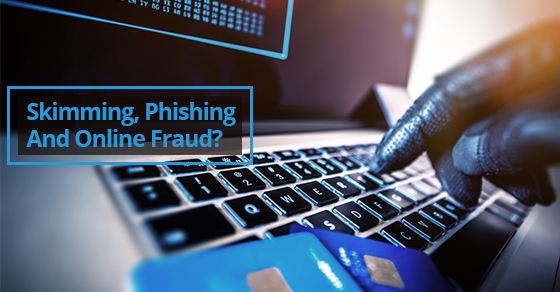You might have heard of the words skimming, phishing and online fraud but are not familiar with what they actually mean. Online fraud is the use of the Internet to defraud individuals by obtaining their personal information and selling it or by making transactions. Skimming and phishing are two examples of online fraud. Here is everything you need to know about these terms in order for you to protect yourself.
What is Skimming?
Credit card skimming occurs when someone obtains your credit card (or bank card) information and use it to make a duplicate of it. A device called a “skimmer” reads your credit card information and is then used to make a counterfeit credit card. This can occur when you go to pay for an item with your credit card and encounter a dishonest employee. The employee then goes on to sell your credit card information to criminals, who then create a counterfeit version of your card or may even just use the credit card information to make a purchase over the Internet or telephone.
What is Phishing?
Phishing is a crime that occurs when you are sent an illegitimate e-mail from your “bank” asking for your credit card information. You might be directed to what appears to be your bank’s website (it might even have a similar similar LOGO and URL) but in fact, it may be a scam. Criminals can remove all of the money from your account in only a couple of hours via phishing.
It is important to know that since e-mail and telephones are not secure, your bank will never ask for this sensitive information via these methods. If you encounter an e-mail or telephone call asking for this information, delete the e-mail or hang up the phone. This is becoming increasingly common now that thieves have had to find new ways to obtain money since microchips were inserted into Canadian bank cards in 2008.
How to Protect Yourself:
- Pay close attention when you give out your credit cards at stores and restaurants to ensure that your credit card information is not being copied. Sometimes skimmers simply look like cellphones. Ensure that you are given back your own card and not a fake one.
- To protect yourself against online fraud, change your online banking password multiple times per year. Don’t choose passwords that could be guessed easily by criminals, such as your birthday, name of your children, etc.
- Don’t give out your credit card information over the phone unless you are sure you are speaking with your financial institution.
- Always examine your bank’s website carefully. If you notice any changes, it is wise to contact your bank and ask them to confirm the change of design before you proceed to log in.
- Look for a padlock symbol in the top right hand corner to ensure that the site you are making a purchase from is a reputable and secure site.

